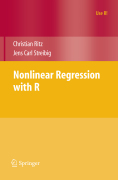
R is a rapidly evolving lingua franca of graphical display and statistical analysis of experiments from the applied sciences. Currently, R offers a wide range of functionality for nonlinear regression analysis, but the relevant functions, packages and documentation are scattered across the R environment. This book provides a coherent and unified treatment of nonlinear regression with R by means of examples from a diversity of applied sciences such as biology, chemistry, engineering, medicine and toxicology. R. Subsequent chapters explain the salient features of the main fitting function nls (), the use of model diagnostics, how to deal with various model departures, and carry out hypothesis testing. In the final chapter grouped-data structures, including an example of a nonlinear mixed-effects regression model, are considered. Unique because it approaches non-linear regression modeling through the functionality available in R, such that the analysis in many respects is carried out using the same commands and functions as would be used to analyze linear or generalized linear or other models in R INDICE: Introduction.- Getting started.- Starting values and self starters.- More on nls ().- Model diagnostics.- Remedies for model variations.- Uncertainty, hypothesis testing and model selection.- Grouped data.- Appendix A: Datasets and models.- Appendix B: Self starter functions.- Appendix C: Packages and functions.- References.- Index.
- ISBN: 978-0-387-09615-5
- Editorial: Springer
- Encuadernacion: Rústica
- Páginas: 144
- Fecha Publicación: 01/02/2009
- Nº Volúmenes: 1
- Idioma: Inglés
